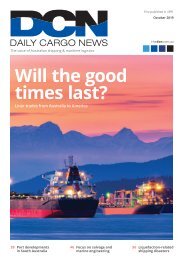DCN May Edition 2019
You also want an ePaper? Increase the reach of your titles
YUMPU automatically turns print PDFs into web optimized ePapers that Google loves.
INDUSTRY OPINION<br />
Meeting the low<br />
sulphur fuel challenge<br />
Angela Gillham examines the trend towards cleaner fuels<br />
and what it is likely to mean in practice<br />
WHILE MOST TIGHTENING OF<br />
ship emissions standards has occurred<br />
in the northern hemisphere, as urban<br />
encroachment in Australia continues, so<br />
will community pressure on authorities to<br />
act here.<br />
It is worth comparing Australian fuel<br />
sulphur standards from other emissions<br />
compliance options will have an impact<br />
on demand for low sulphur fuel and will<br />
influence supply and price. It is important<br />
to note the IMO fuel availability study,<br />
commissioned in the lead up to the decision<br />
on the sulphur cap implementation date,<br />
found the global refining industry has<br />
capacity to meet projected global demand.<br />
sources. While there has been a tightening<br />
of global fuel standards and emissions<br />
regulations for international shipping, the<br />
current Australian requirement for sulphur<br />
content in automotive diesel remains<br />
considerably more stringent (Table 1).<br />
This is likely to attract further community<br />
attention in the future.<br />
LOW SULPHUR FUEL<br />
Fuel low enough in sulphur to be<br />
compliant, in reality, can mean different<br />
things. Lower sulphur content can be<br />
achieved by blending low sulphur fuels and<br />
heavy fuel oil or further refining HFO, to<br />
produce gasoil (diesel). Sulphur content is<br />
just one of many specifications and there<br />
IMPACT ON INDUSTRY<br />
Total annual marine fuel demand is around<br />
400m tonnes and climbing. The global<br />
sulphur cap will have a significant impact<br />
and as suppliers attempt to meet this new<br />
mix of marine fuel demand there will be a<br />
price increase, possibly a significant one.<br />
A recent survey of vessel operators by<br />
MIAL found average expectation of the cost<br />
differential between HSFO and compliant<br />
fuel was $250, and estimates ranged from<br />
$75 to $740 per tonne.<br />
There are several compliance options<br />
available to shipowners, including using<br />
low sulphur fuel, alternative fuels such as<br />
liquefied natural gas and ‘drop in’ biofuels<br />
and renewable diesel, and exhaust gas<br />
cleaning systems – each having technical<br />
challenges, limitations and accessibility<br />
issues. The degree of uptake of each of these<br />
are some safety concerns around the use of<br />
blended fuels to achieve the 0.5% limit, the<br />
properties of these fuels and compatibility<br />
with existing marine diesel engines.<br />
Work is underway to update guidelines<br />
relating to the relevant ISO specifications<br />
to address the safety concerns using new<br />
fuel blends.<br />
In Australia, low sulphur diesel options<br />
are limited as is refining capacity. Along<br />
with some high sulphur heavy fuel oil and<br />
petrol, the major Australian fuel suppliers<br />
import one grade of diesel at 0.001%<br />
sulphur – this is automotive diesel – a<br />
costly option. Fuel suppliers have indicated<br />
they are planning to have low sulphur fuel<br />
oil available at selected Australian ports,<br />
but ship operators wanting access to this<br />
product need to communicate this early to<br />
ensure capacity.<br />
TABLE 1: FUEL SULPHUR LIMITS IN AUSTRALIA<br />
REGULATED LIMIT<br />
DIESEL USE % PPM<br />
Automotive diesel 0.001 10<br />
Current international shipping 3.5 35000<br />
2020 international shipping 0.5 5000<br />
2020 international shipping ECA 0.1 1000<br />
Angela Gillham, deputy CEO, Maritime Industry<br />
Australia<br />
LNG<br />
LNG contains virtually no sulphur and, in<br />
recognition of the opportunities that LNG<br />
represents particularly for Australia, the<br />
number of newbuilds planned or operating<br />
within the Australian market is growing.<br />
Perceived limitations are loss of cargo<br />
space due to the larger fuel storage area and<br />
current lack of distribution networks and<br />
bunkering infrastructure.<br />
LNG has the added benefit of burning<br />
with about two thirds of the greenhouse<br />
gas emissions of diesel. LNG is a powerful<br />
greenhouse gas, however, and methane<br />
slippage has been flagged as an issue.<br />
BIOFUELS AND RENEWABLE DIESEL<br />
The use of biofuels and renewable diesel<br />
presents a significant opportunity with<br />
little to no sulphur content. There are a<br />
variety of drop-in biofuels and renewable<br />
diesel products available that can be used<br />
in existing marine diesel engines. The main<br />
challenge for wide-scale adoption of these<br />
fuels is the scalability of production to<br />
meet the large volumes required.<br />
MIAL<br />
18 <strong>May</strong> <strong>2019</strong><br />
thedcn.com.au
















